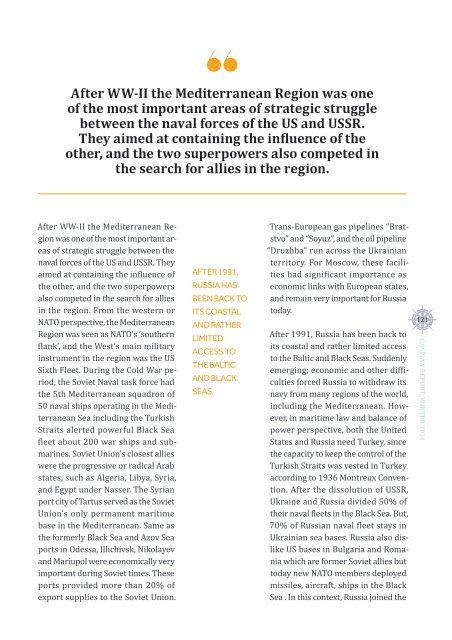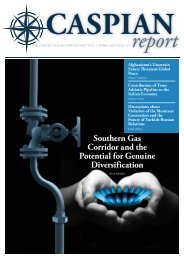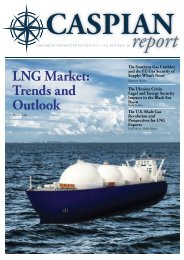Caspian Report - Issue 06 - Winter 2014
Create successful ePaper yourself
Turn your PDF publications into a flip-book with our unique Google optimized e-Paper software.
After WW-II the Mediterranean Region was one<br />
of the most important areas of strategic struggle<br />
between the naval forces of the US and USSR.<br />
They aimed at containing the influence of the<br />
other, and the two superpowers also competed in<br />
the search for allies in the region.<br />
After WW-II the Mediterranean Region<br />
was one of the most important areas<br />
of strategic struggle between the<br />
naval forces of the US and USSR. They<br />
aimed at containing the influence of<br />
the other, and the two superpowers<br />
also competed in the search for allies<br />
in the region. From the western or<br />
NATO perspective, the Mediterranean<br />
Region was seen as NATO’s ‘southern<br />
flank’, and the West’s main military<br />
instrument in the region was the US<br />
Sixth Fleet. During the Cold War period,<br />
the Soviet Naval task force had<br />
the 5th Mediterranean squadron of<br />
50 naval ships operating in the Mediterranean<br />
Sea including the Turkish<br />
Straits alerted powerful Black Sea<br />
fleet about 200 war ships and submarines.<br />
Soviet Union’s closest allies<br />
were the progressive or radical Arab<br />
states, such as Algeria, Libya, Syria,<br />
and Egypt under Nasser. The Syrian<br />
port city of Tartus served as the Soviet<br />
Union’s only permanent maritime<br />
base in the Mediterranean. Same as<br />
the formerly Black Sea and Azov Sea<br />
ports in Odessa, Illichivsk, Nikolayev<br />
and Mariupol were economically very<br />
important during Soviet times. These<br />
ports provided more than 20% of<br />
export supplies to the Soviet Union.<br />
AFTER 1991,<br />
RUSSIA HAS<br />
BEEN BACK TO<br />
ITS COASTAL<br />
AND RATHER<br />
LIMITED<br />
ACCESS TO<br />
THE BALTIC<br />
AND BLACK<br />
SEAS.<br />
Trans-European gas pipelines “Bratstvo”<br />
and “Soyuz”, and the oil pipeline<br />
“Druzhba” run across the Ukrainian<br />
territory. For Moscow, these facilities<br />
had significant importance as<br />
economic links with European states,<br />
and remain very important for Russia<br />
today.<br />
After 1991, Russia has been back to<br />
its coastal and rather limited access<br />
to the Baltic and Black Seas. Suddenly<br />
emerging; economic and other difficulties<br />
forced Russia to withdraw its<br />
navy from many regions of the world,<br />
including the Mediterranean. However,<br />
in maritime law and balance of<br />
power perspective, both the United<br />
States and Russia need Turkey, since<br />
the capacity to keep the control of the<br />
Turkish Straits was vested in Turkey<br />
according to 1936 Montreux Convention.<br />
After the dissolution of USSR,<br />
Ukraine and Russia divided 50% of<br />
their naval fleets in the Black Sea. But,<br />
70% of Russian naval fleet stays in<br />
Ukrainian sea bases. Russia also dislike<br />
US bases in Bulgaria and Romania<br />
which are former Soviet allies but<br />
today new NATO members deployed<br />
missiles, aircraft, ships in the Black<br />
Sea . In this context, Russia joined the<br />
121<br />
CASPIAN REPORT, WINTER <strong>2014</strong>










